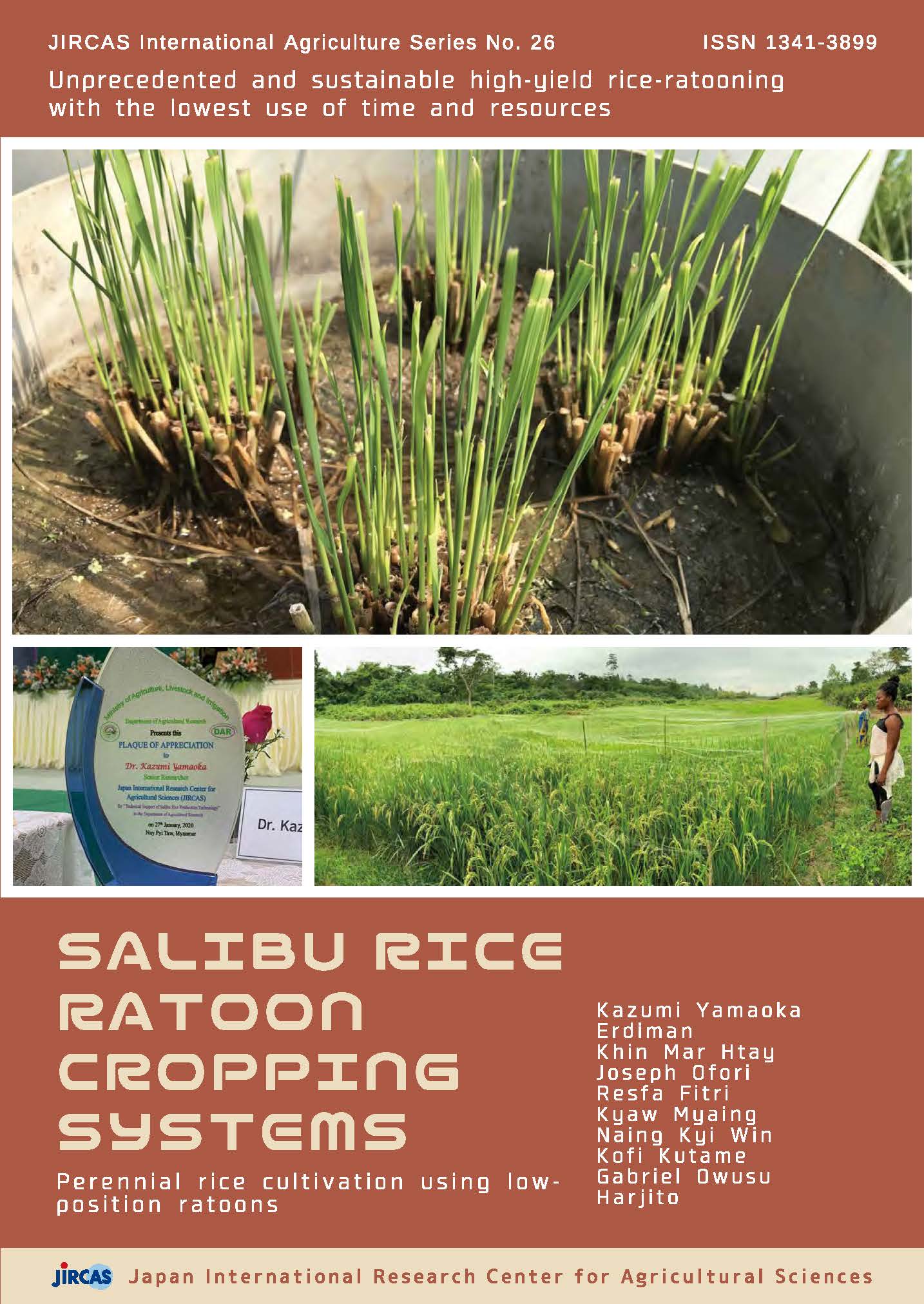SALIBU Rice Ratoon Cropping Systems : Unprecedented and sustainable high-yield rice-ratooning with the lowest use of time and resources : Perennial rice cultivation using low-position ratoons
国際農業研究叢書
| ISSN | 13413899 |
|---|---|
| 書誌レコードID(総合目録DB) | AN10538429 |

本文フルテキスト
Table of contents
-
- Foreword, p.i
- Acknowledgment, p.iii
- Table of contents, p.v
-
- Introduction — SALIBU rice ratoon cropping systems defeat the common knowledge of conventional ratooning, p.1
- Our mission for ensuring to feed the future world population sustainably, p.1
- Role of rice in the world, p.1
- Another mission: ending hunger and eradicating poverty in developing regions, p.2
- Solving the two missions and many problems at once — SALIBU rice ratoon cropping systems, p.4
- Erdiman’s Challenge, p.5
- Outline and purpose of this book, p.6
PART ONE: Technological introduction on the SALIBU rice ratoon cropping systems
-
- Chapter 1: Review of studies on rice ratooning, p.9
- Morphology, physiology and ratoon development earliness, p.10
- Varietal potentiality, tillering capacity, and main crop growth duration, p.10
- Harvest timing of the main crop and cutting height of the stubble, p.11
- Water and fertilizer management, p.12
- Differences between the traditional ratoon cropping and SALIBU rice ratoon cropping systems, p.13
- Chapter 2: Encounter with SALIBU rice ratoon cropping systems and the launch of a research project, p.21
- A fateful encounter with the SALIBU ratoon cropping systems and Mr. Erdiman, p.21
- The first business trip report, p.22
- Launching the research project on the SALIBU rice ratoon cropping systems, p. 23
- Chapter 3: Beginning of joint research, p.25
- Mr. Erdiman’s approach in Sumatra, p.25
- Technology transfer from Sumatra to overseas for the first time, p.26
- Field Survey in West Sumatra Province (May 2017), p.28
PART TWO: Studies on SALIBU rice ratoon cropping systems in three countries
-
- Chapter 4: Change of yield in consecutive nine crops in large open-air pots – Myanmar I, p.31
- Approach and method, p.31
- Results and discussion, p.33
- Conclusion and recommendations, p.35
- Chapter 5: Comparison of water productivity by field cultivation test – Myanmar II, p.36
- Introduction, p.36
- Research methods, p.37
- Results, p.41
- Conclusion and recommendations, p.43
- Additional cultivation tests to compare the different ways of cutting stems at harvest — number of times, timing, and position, p.45
- Research methods, p.45
- Results and discussion, p.48
- Conclusion and recommendations, p.50
- Chapter 6: Comparative field cultivation test for 33 cultivars- Myanmar III, p.52
- Introduction, p.52
- Materials and Methods, p.52
- Data Gathering, p.59
- Results and Discussion, p.60
- Considerations and trial selection of suitable varieties for SALIBU cropping systems, p.65
- Conclusion, p.68
- Chapter 7: Introducing combine harvester into the field trial for 11 rice varieties and a cultivation test in a farmer’s field – Myanmar IV, p.71
- Introducing a combine harvester into the field trial for 11 rice varieties, p.71
- Materials and methods, p.72
- Results and discussion, p.73
- Conclusion and recommendations, p.80
- Supplementary cultivation test in a farmer's field, p.81
- Chapter 8: Profitability of SALIBU rice ratoon cropping systems - Indonesia, p.85
- Introduction, p.85
- SALIBU technology and using agricultural resources efficiently, p.88
- Field experiments involving SALIBU technology in Indonesia, p.89
- Profitability of SALIBU technology, p.92
- Conclusion and recommendations, p.96
- Chapter 9: Comparison of water productivity by field cultivation test – Ghana I, p.97
- Introduction, p.97
- Methods, p.99
- Data collection, p.103
- Results and discussion, p.104
- Conclusion, p.109
- Recommendations, p.109
- Chapter 10: Cultivation by farmers in rain-fed paddy fields – Ghana II, p.111
- Description of site, p.111
- Methodology, p.111
- Data collection and results, p.112
- Conclusion and recommendations, p.113
- Chapter 11: Farmer-Based Organizations — Ghana III, p.116
- Introduction, p.116
- Rice value chain in Ghana, p.116
- Current status of rice farmers in Ghana, p.120
- Current status of agricultural extension delivery services in Ghana, p.123
- Establishment of the field study formation in Ghana, p.124
- Policy target: Autonomous technology up-taking by FBOs with high centripetal force, p.127
- Strengthening rice farmers’ FBO: Jointly invest funds in FBO and use them as collateral to get a loan from a bank to jointly purchase agricultural machinery, p.129
- Results Achieved, p.135
- Chapter 12: General considerations and conclusions, p.137
- Characteristics of SALIBU rice ratoon cropping systems considering plant physiology, p.137
- Conclusion and recommendations, p.138
- Other points to keep in mind for the practical application of SALIBU rice ratoon cropping systems, p.139
-
- Annex 1, p.142
- References, p.158
- Postscript, p.163
- About authors with photos, p.164
| 刊行年月日 | |
|---|---|
| 作成者 | Kazumi Yamaoka Erdiman Khin Mar Htay Joseph Ofori Resfa Fitri Kyaw Myaing Naing Kyi Win Kofi Kutame Gabriel Owusu Harjito |
| 公開者 | Japan International Research Center for Agricultural Sciences |
| オンライン掲載日 | |
| 国立情報学研究所メタデータ主題語彙集(資源タイプ) | Book |
| 号 | 26 |
| 言語 | eng |
